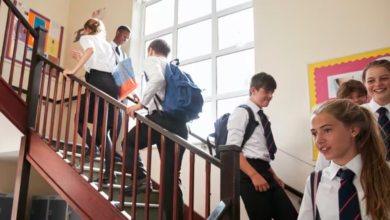
In many ways, 2023 is set to be a year of change, turbulence, and uncertainty in the education sector of Aotearoa. Term 1 marks the first term that the new Aotearoa New Zealand Histories curriculum will be taught nationwide, marking the first of a wider New Zealand curriculum refresh that will unfold over the next three years.
Read the Term 1 edition of School News HERE.
Additionally, pilot programmes will begin for the National Certificate of Educational Achievement (NCEA) change programme, described by the Ministry of Education on their website as “the most significant reform of NCEA since the qualification was introduced”.
While the Ministry of Education describes the National Curriculum refresh and NCEA changes as being “well aligned”, those on the ground have their doubts, as new NCEA standards look to be developed before changes to the curriculum are implemented.
Although the commitment to Te Tiriti and mana ōrite frameworks have been praised, educators are concerned over the support available for implementation of a new curriculum amidst ongoing changes to certificate standards. Educators are worried that a rollout that is too generalised, inadequately supported and resourced will lead to continued inequitable outcomes.
The timeline
2023
Curriculum refresh:
- Aotearoa New Zealand Histories curriculum will now be taught in all schools.
- Mathematics and Statistics and English curriculums developed over 2022 will now be available for teaching.
- Technology, Arts and Science curriculums will undergo design and feedback stages.
NCEA change programme:
- Pilot of NCEA Level 1 subjects (developed 2021).
- Mini-pilot of NCEA Level 2 Te Reo Māori.
- Pilot of Te Marautanga o Aotearoa (TMoA) NCEA Level 1 Wāhanga Ako.
- Mini-pilot of TMoA NCEA Level 2 Wāhanga Ako.
- Development of materials for NCEA Level 3 NZC subjects.
- Develop TMoA NCEA Level 3 Wāhanga Ako materials.
- Te Ao Haka implemented across all three NCEA levels.
- Te Reo Matatini me to Pāngarau | Literarcy and Numeracy, implemented across all three NCEA levels dependant on sector readiness.
- Vocational Pathways refresh phased in.
2024
Curriculum refresh:
- Refreshed Technology, Arts and Science curriculums will be available for teaching.
- Learning Languages, Health and Physical Education curriculums will undergo design and feedback processes.
NCEA change programme:
- NCEA Level 1 subjects.
- TMoA NCEA Level 1 Wāhanga Ako will be implemented.
- NCEA Level 2 subjects will go into pilot stages.
- Mini-pilot of NCEA Level 3 Te Reo Māori.
- Full pliot of TMoA NCEA Level 2 Wāhanga Ako.
- Mini-pilot of TMoA NCEA Level 3 Wāhanga Ako.
2025
Curriculum refresh:
- By the end of 2025, all schools will be operating on the refreshed New Zealand curriculum.
- Ongoing implementation and support.
NCEA change programme:
- NCEA Level 2 subjects implemented.
- TMoA NCEA Level 2 Wāhanga Ako implemented.
- Full pilot of NCEA Level 3 subjects.
- Full pilot of TMoA NCEA Level 3 Wāhanga Ako.
2026
NCEA change programme:
- NCEA Level 3 subjects implemented
- TMoA NCEA Level 3 Wāhanga Ako implemented

The positive
Leanne Otene, Tumaki of Manaia View School in Whangārei, and part of the design team for the new Aotearoa New Zealand Histories curriculum, describes the curriculum refresh as “absolutely necessary to bring us into the 21st century”.
“We need to change our traditional approach to education, and the curriculum refresh is definitely moving us toward ensuring our young people have the knowledge, the skills and the attributes that are required for future focused employment,” Otene said.
Crucially, the refresh is underpinned by the values of Te Tiriti. Schools are being encouraged to reach out to local hapū and iwi to begin a process of local curricula codesign, which aims to address existing inequities and ensure the values of te ao Māori are present throughout learning environments.
In the original announcement of the curriculum refresh, Associate Minister of Education Kelvin Davis said the most important changes were to “address equity, trust and coherence through integrating the He Tamaiti Hei Raukura framework”.
Davis continued: “`Ākonga need to learn from a curriculum that is rich in te reo and tikanga Māori, is meaningful to them and their whānau, and equips our tamariki with the skills and wellbeing they need in this ever-changing world.”
Davis said the curriculum would “strengthen Te Marautanga o Aotearoa in partnership with whānau, hapū and iwi, grounded in the key values and aspirations of te ao Māori.”
And it seems that aim has been met, with Otene describing the whakapapa of the curriculum as “absolutely well thought through”.
“The framework has been developed and co-designed with mana whenua. It’s a wonderful framework.”
Patrick Gale, principal of Rangitoto College, New Zealand’s largest secondary school, agrees. He said “it’s great we’re now teaching local histories, and this has been mandated by the Ministry – we’re very supportive of that.”
Another welcome aspect of the curriculum refresh is its aim to “provide greater clarity”. Gale notes that “people
are eager to embrace a much more detailed and challenging curriculum”. He said that “students need to be challenged and to perform better on both national and international levels. And the curriculum is the key founding document that guides us through that process”.
Liam Rutherford, president of NZEI Te Riu Roa, concurs. He noted that across the board, he’s seen that people “are really excited about the evolution of a new curriculum, particularly around that greater focus on the development of local curriculum”.
Otene said she’d also like to recognise the extensive consultation that occurred ahead of the rollout, acknowledging that “the Ministry of Education is listening to the sector, and it’s important that continues. They have been proactive in ensuring the various sector bodies are involved. As that continues, we’ll continue to tell them what’s needed. That needs to be heard too”.

The challenges
Although the ministry and the wider sector agree about what changes are needed – clearer learning objectives at each level; localised, culturally specific curriculums; greater equity of educational outcomes – it seems the implementation of said changes remains contentious.
Gale notes that although Rangitoto College is well placed to enact the curriculum changes, not every school would have had the connections or resources to develop relationships with local mana whenua, as they have.
“So many schools are suddenly scrambling for information,” he notes. Gale also points out that, somewhat ironically, through the very process of trying to embed te ao Māori in our kura, “potentially some of the tikanga that are associated with forming those good relationships have been lost”.
Gale said he would have liked to see “a more considered, well designed, supportive approach which had engaged with those local historians and iwi before the rollout.”
Otene agrees, noting that her school and others which have had the support of MAC, the Māori Achievement Collective, will be well placed to seek the support of local mana whenua, but not every school will be in the same position.
“There is going to need to be more support in regions where they haven’t got these relationships in place. Particularly in larger urban centres, especially Auckland, there isn’t always that historic relationship.”
She said that in many areas, there’s a “need to develop a relationship first with mana whenua before [schools] start asking and demanding they work with them. That takes trust and hui, and it won’t happen overnight.”
Rutherford raised similar concerns, noting: “there’s quite a big gap between those people that are on the journey, and those that aren’t yet.” He said it’s about making sure that support is available to ensure “people have got the space and time to be able to engage properly”. Rutherford believes this support will be “vital for success”, especially in the light of past curriculum changes where support has not been adequately placed.
Otene, who is also the president of the New Zealand Principals’ Federation, concurs. She said principals have had various demands placed on them over the past few years, especially over the pandemic, “so to meet the deadlines for consultation, to critically look at them and see how they can give the best quality feedback to the ministry – it’s been a real big ask. As individual principals, I don’t think we have given them enough opportunity.”
Although the ministry has announced four teacher-only days over 2023 and 2024 to support the curriculum changes, Otene and Gale agree schools need more.
Otene’s biggest worry is that there won’t be enough people to support schools, especially in the timeframe laid out by the Ministry. Schools that must rely on Ministry of Education or external professional development support may find themselves missing out, says Otene.
“Every school is at a different stage and understanding with the various different curriculum documents,” Otene points out. Currently, the Ministry is considering a “cluster” approach with the teacher-only days, aggregating professional development supports for schools in similar areas. But different schools will need different support, even within “clusters”, notes Otene, and this approach negates the emphasis on school-specific curricula.
In addition to the concerns around professional development, Gale raises questions on the timing of rollouts. He says that because the NCEA refresh is coming ahead of the curriculum refresh, it will inevitably drive the new curriculum.
“There is no way that should have been allowed to happen,” says Gale. “While we appreciate teacher only days and those sorts of things, the whole process would have been eased if it’d been effectively managed from the outset, with the curriculum refresh coming first and then the assessment tools coming second.”

Gale also believes that the new standards are “still too generic and therefore lack depth”. He would like to see more specific criteria put in place for each year group. He believes the current model, which groups some years together, will “require teachers to make their own decisions about what sits where”, leading to potential disparities in standards between schools, and inequitable outcomes.
Although all three educators who spoke to School News NZ were hopeful for the changes ahead for the sector, all had doubts about how the changes would play out.
As Rutherford put it: “[educators] would be really disappointed if we didn’t achieve that vision of the refresh because we didn’t ensure schools were in a position to implement it.”









